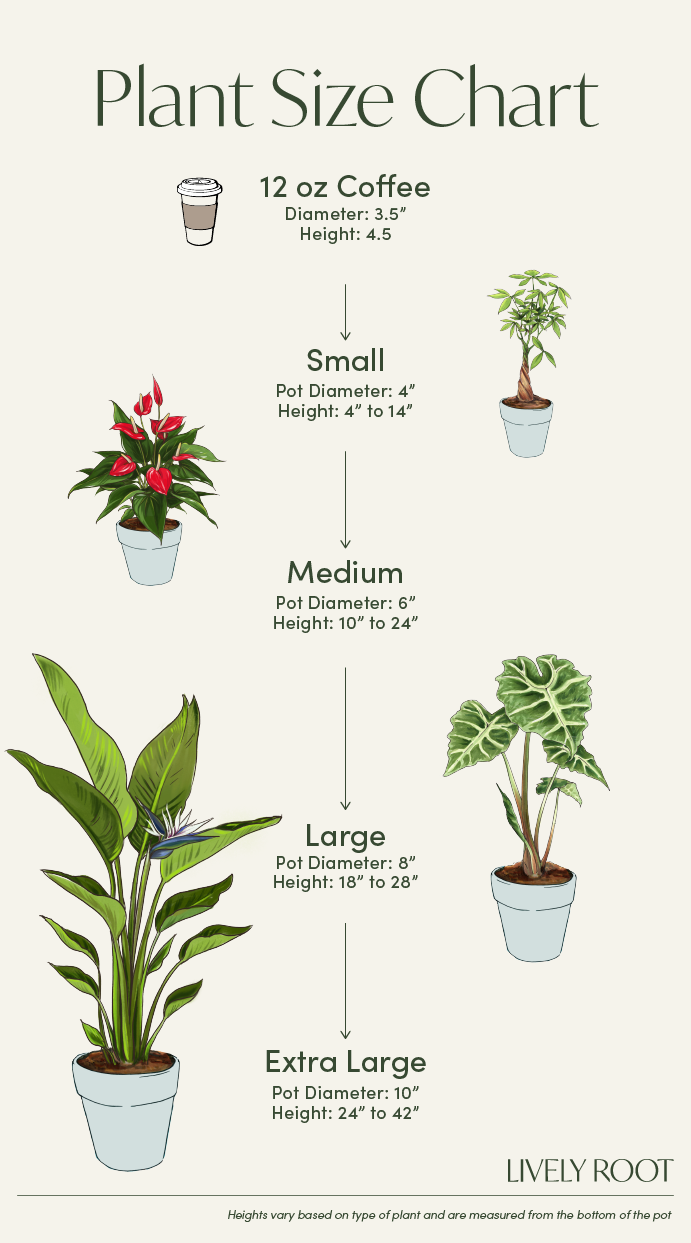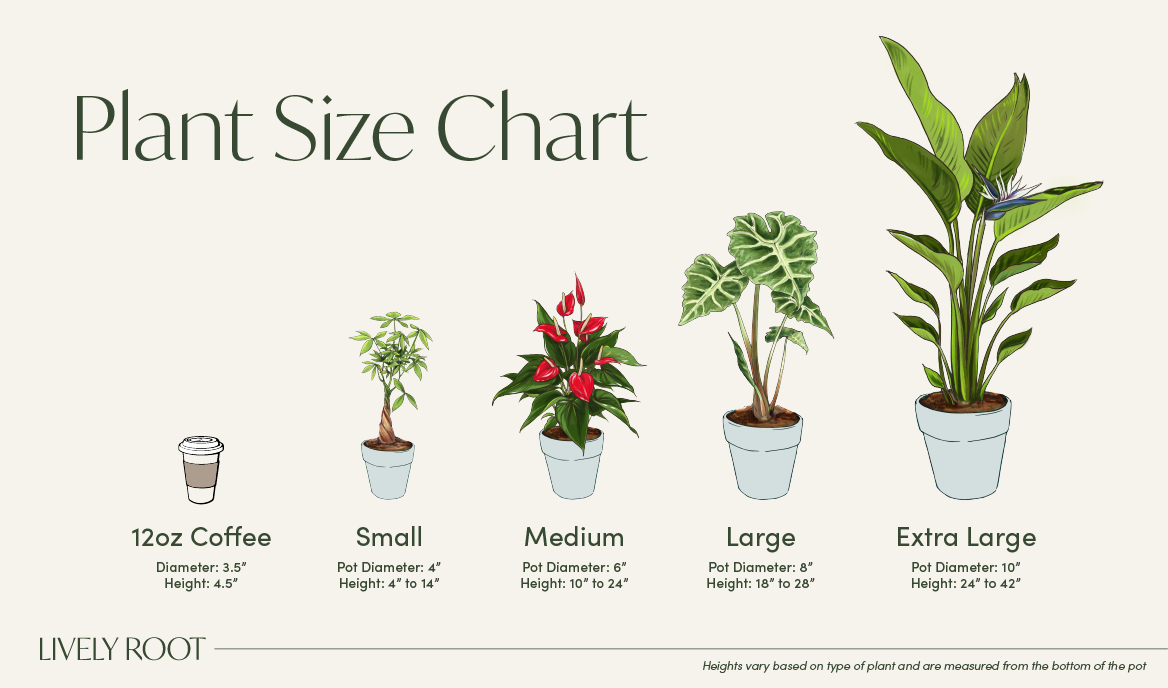

The impressive Flaming Sword Bromeliad (Vriesea splendens) shows off their sword-shaped red flower spike and dark green with purple and black stripes. They don't bloom until they are aged three to five years. Long yellow tubular flowers will emerge from the red flattened bracts for greater contrast. Expect the bracts to last several weeks to give a great show. Once they fade, pups will form, and propagation naturally begins to recreate the festive look in the future.
Bromeliad Vriesea Care Guide & Presentation

Set this plant in a place where they will receive bright, indirect light for favorable results.
Use unsoftened, filtered, bottled, or tap water sitting 24 hours to release the chemicals and water enough that the water discharges out of the drainage holes. Once the water is fully drained, replace them into the cache or decorative pot. Replenish the water when the soil is dry or when your plant meter registers at 3-4.
Bromeliads need humidity at a rate of 40-60%. Use a pebble tray, humidifier and group plants together to raise the humidity levels.
This tropical plant loves warm climates and humidity.
In nature, this plant will grow attached to the side of a tree and the canopy of a tree from direct sun.
Fertilize monthly during their growing period while the flower is in bloom with a balanced liquid fertilizer and a time release granular soil fertilizer. Reduce during the fall and winter months while the plant is in their dormant phase. When fertilizing, don't get the fertilizer in the urn or tank as this can burn the plant.
To repot a bromeliad grown out of their container, get a larger one that's 2 inches wider with drainage holes. Make sure the container is sturdy enough if the bromeliad is top-heavy. Use a mixture of 1/2 well-draining potting mix, 1/4 perlite, and 1/4 orchid bark. Place a piece of screening at the bottom of the container over the drainage hole to secure the soil and allow to drain. Fill the container's bottom with the mix, then place the bromeliad in and fill around the edges. Leave at least an inch of room from the top of the container to avoid water spillage. Water the plant well. Add them to an area with bright, indirect sunlight and humidity to let them settle into their new environment.
When the flower fades and turns brown, remove the flower stalk as far down as you can cut with sharp clippers. Once pups or offshoots are one-third the size of the mother plant, they can be removed with their roots attached and planted. The mother plant will not produce any more flowers and eventually, die.
To propagate the bromeliad pups, let the pups grow on the mother plant until they reach at least 5 inches or a third of the original stalk's size. Take the mother plant out of the pot. Cut the mother plant top off to see the pup and remove all the dead leaves. Pull away the pup and the small root system with them. You may need to use pruners to help remove the roots and pup. Some arm strength may be required to wedge them away from the parent plant. Once you have them separated, you can use a bromeliad medium (1/2 well-draining potting mix, 1/4 perlite, and 1/4 orchid bark) to repot them in. Use a container with drainage holes and nothing too big for the pup. Allow at least 2 inches of soil to surround the pup. You will bury the roots very shallow in the soil so as not to cause rotting on the leaves. Tamp the mix down to secure the plant. Water from overhead to give them a drink and water well so it drains through the hole. Set them in a bright, indirect sunny area.
Vriesea Bromeliad: Overview
The exotic Vriesea Bromeliad (Vriesea splendens) is a tropical plant with long, slightly arched leaves. Its long-blooming central flower spike resembles a vermilion red sword, which gave this Vriesea its common name – the Flaming Sword Plant. Vriesea is an epiphyte, often growing on tree trunks or on top of accumulated plant debris on the forest floor in the wild.
When flowering, the Bromeliad Vriesea can reach about 2.5 ft. in height. While usually grown indoors, this plant can thrive on patios and porches in hardiness zones 10-12. The Flaming Sword Plant belongs to the Bromeliad family and grows natively in the rainforests of Venezuela, Trinidad and Tobago, French Guyana, and Suriname.
Like other bromeliads, the Vriesea plant lives for 3 to 5 years, blooming only once and then growing offshoots called pups, which can be propagated into new plants. Bromeliads require bright, indirect sun to bloom and flourish, but they are otherwise undemanding plants that need little water. Vrieseas are also pet-friendly plants and don’t contain toxins harmful to cats or dogs.
Bromeliads symbolize love, happiness, and renewal; the Flaming Sword Bromeliad is also associated with strength and protection.
Other colorful Bromeliads include the cute and compact Bromeliad Neoregelia or the Guzmania Bromeliad, which comes in various vibrant colors.
Bromeliads: Benefits
- Great air purifier
- Bright and unusual plant with a tropical vibe
- Easy-care plant
- Non-toxic to pets
- Gorgeous flowering plants for interior decoration
Vriesea Splendens: Care Guide
Despite its glamorous tropical look, Bromeliad Vriesea care is simple and won’t take much of your time. Here are some Vriesea Splendens care tips to keep this plant in stunning shape:
Watering and Humidity
Proper Vriesea Bromeliad care begins with knowing how to water it. Bromeliads are prone to root rot when watered too often. Let the soil of your Bromeliad Flaming Sword dry well before repeated watering and don’t let it sit in water. Use distilled or filtered water for the best Vriesea care. Increase humidity around your plant by putting a pebble tray under its pot, misting it regularly, grouping it with other plants, or using a humidifier.
Light and Temperature
Your Vriesea will grow best if it receives 4 to 6 hours of medium to bright light. Avoid direct sunlight, however, as it can scorch the plant’s leaves. The best locations are south, east, or west-facing windows. If you’re growing your Flaming Sword Vriesia outdoors, place it in partial shade and bring it indoors if the temperature falls below 60°F. Vriesea grows best in warm and humid environments. The best temperature for your plant is 60℉ to 80℉.
Soil and Repotting
Use well-draining bromeliad or orchid potting soil for this plant. Check that the pot has drainage holes to prevent overwatering. Repot your plant every two to three years or whenever it grows too large for its current container. Use a stable, 2-inch larger pot that will support your plant with its tall flower spike.
Feeding and Propagation
Once a month, feed your plant with a balanced liquid fertilizer. For the best Flaming Sword plant care, only fertilize during the growing season, letting the plant rest during its dormant phase in winter. Propagating Bromeliads from their pups is easy. You can detach them from the mother plant and repot them when they grow large enough. Plant them in well-draining soil and don’t overwater.
Pruning, Cleaning, and Common Issues
Flaming Sword Bromeliad care doesn’t include pruning as the plant grows in a compact, neat rosette with one central flower spike. Wipe dust from the leaves if necessary and keep the soil clean from debris to prevent root rot. Brown spots on the plant’s leaves and flower bracts are caused by overexposure to direct sunlight. Check your plant’s leaves for scales and mealybugs and, if necessary, use an organic insecticide.
Flaming Sword Plant: Placement, Companion & Alternative Plants
Vriesea looks stunning as a centerpiece plant and several of these plants make for a spectacular but easy-care tropical display.
Best Locations & Uses
- Perfect low-maintenance office or bedroom plant
- Great for plant lovers with pets
- Ideal for beginner indoor gardeners
- Suitable as a porch plant in warmer climates
- Amazing gift plant that symbolizes love and happiness
Companion Plants
The Vriesea Flaming Sword looks amazing combined with other plants; its tropical appearance will help you create an exotic and lush plant display.
- Philodendron Ginny with Totem (Rhaphidophora tetrasperma): A beautiful climbing plant that looks like a mini version of the Monstera Deliciosa, Philodendron Ginny loves warmth and high humidity and grows best if provided with a moss pole or other support for climbing.
- Peace Lily Plant (Spathiphyllum): With its arched leaves and white blooms, the Peace Lily is a must-have indoor plant that instantly adds elegance and poise to any interior.
- Ruby Rubber Tree Plant (Ficus robusta 'Ruby'): The delightful Ruby Rubber Tree Plant is an easy-care indoor tree with charmingly variegated leaves edged with pink.
Alternative Plants
Here are 3 alternative plants with colorful, eye-catching flowers:
- Flamingo Flower (Anthurium spp. – Red): The bright red, heart-shaped blooms of the Flamingo Flower are hard to miss, making this low-maintenance tropical plant an amazing addition to your collection.
- Orange Bird of Paradise (Strelitzia reginea): With vivid, exotic flowers and decorative, large leaves, the sun-loving Orange Bird of Paradise adds a tropical mood to any living space.
- Zebra Plant (Aphelandra squarrosa): Somewhat high-maintenance, the Zebra Plant requires just the right amount of water and humidity, but it will enchant you with its spike of bright yellow flowers if given some extra care.
Get the Gorgeous Flaming Sword Bromeliad From Lively Root
Add some tropical vibes to your indoor space with a glamorous Vriesea for sale from Lively Root!








































